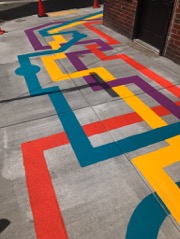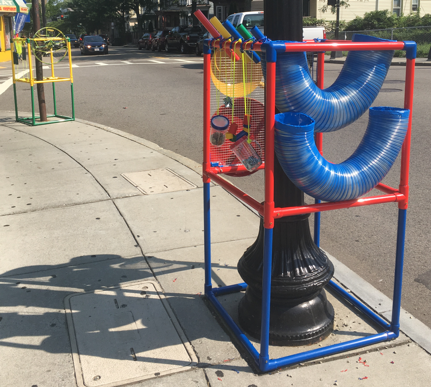Imagining a More Playful Boston

2018 MONUM Fellow
“Wanna come over and play?,” five-year old me asked my best friend on the phone. What, exactly, we were going to “play” wasn’t defined—at that age, everything had the potential to be playful, from toys and games to cardboard boxes to sticks. As we grow older, and as we become more scheduled, some of that openness about play starts to dissipate and we begin to think of it in more confined times and spaces—meet me at the park to play soccer, let’s play on the playground at recess, come over and play this new game.
Boston does a great job of facilitating this organized type of play–95% of Bostonians are within a 5-minute walk of a park or open space, and unlike many other cities, playgrounds abound. But what can happen as we start to place limits on play is that it starts to sound like a “nice to have”, something that is non-essential, or not for me. We might even start to feel like we’re too old to play, we don’t have time to play, or can’t play.
My summer fellow project with the Mayor’s Office of New Urban Mechanics (MONUM) was to test ways to get back to this youthful exuberance and re-expand how we, as a City, think about play: that it can be for people of all ages, in designated places and beyond. The entire City can be playful.

But first: why, exactly, do we care about play? Shouldn’t the City be prioritizing things like affordable housing or bike lanes or sidewalk repairs? These were questions I asked myself during my first few days as a MONUM Fellow. But as I reviewed the research and began to talk to people about my project, I quickly saw why play is so important. Play is a safe way to test boundaries and learn to engage in and resolve conflict successfully. It facilitates problem solving, creative thinking, and resilience. It can be a fun way to get exercise. It sparks conversations that might not otherwise happen and it is a great way to release stress.
And so, I dove into Play Around the City, a call to playfully redesign four Boston Public School Bus stops, in East Boston, Roslindale, Dorchester, and Roxbury. Play Around the City is a project of MONUM’s successful Public Space Invitational, a civic design competition to think differently about public spaces and how they are designed. The goal was to test what happens when there is a dash of playfulness in an unexpected place, like a sidewalk or a bus-stop, somewhere it doesn’t have to be sought out. Does it change how Bostonians feel about their city? Their commute? Their neighbors?

In real terms, my task was to solicit ideas, lead a jury selection process, and then shepherd the chosen installations through the often opaque City processes to take them from idea to execution. I worked closely with the winning designers and the Department of Public Works to ensure our projects met sidewalk requirements for safety and accessibility, and navigated the permitting, insurance, and funding logistics. I also met with community centers, neighborhood associations, church groups, local advocates, business owners, and residents to collect feedback and learn and share about play. One Monday, I sat on the sidewalk and painted alongside the artist for the Roxbury installation, Lisa Jeanne Graf, her family, the Mayor’s Mural Crew, local muralist Jason Boucher, and finally, a group of kids from the Pleasant Hill Ministry Baptist Church Peace Program. I shuttled cones and obsessed about the weather with artist Liz LaManche, who installed Mystery Map in East Boston. I watched kids and adults explore the EcoSonic Playground as I helped secure it to the Dorchester location with Professor of Music Elissa Johnson Green. Next week, Roslindale Wants to Play’s Wheel of Fun is installed, and I cannot wait to see the response.
Because this project was implemented during my time as a Fellow, I had a chance to truly experience highs and lows of making a new project happen in the City. There was no set process to follow, and I often had to explain myself and my project as I moved from department to department. A key part of my role was the less “fun” part of play: to learn what it means, logistically, for a City to be playful.

While Play Around the City allowed us to map out one possible path for playful projects, there are still many opportunities to make it easier for Bostonians to reimagine our spaces. MONUM’s dedicated team of creative thinkers, problem solvers, and relationship builders, will continue to identify and create new pathways, alongside many wonderful partners including the Boston Children’s Museum, Playworks, the Mayor’s Education Cabinet, and the Office of Resilience and Racial Equity. I look forward to watching playfulness spread to more and more Departments, infiltrating our daily routes and tasks with little pops of fun and connection.
What I learned most is that people like to play. One of the best parts of my summer was during implementation, when residents would ask about the projects, make suggestions, and talk about some of their favorite ways to play. Seeing the installations led people to think creatively about spaces and other ways Boston could be playful. These were relaxed and fun conversations. Play seemed to create a safe and positive way to interface with the City, put a more human face on a sometime imposing entity, and to make people want to approach and engage. People wanted to partner, to participate. This is exactly what we want in a democracy.
About Emily: Emily graduated from Amherst College with a Bachelor’s Degree in Psychology. She served as an AmeriCorps VISTA and spent several years working in the Boston nonprofit sector. She is currently pursuing her Master of Business Administration in Social Impact and Master of Science in Digital Innovation at Boston University Questrom School of Business.